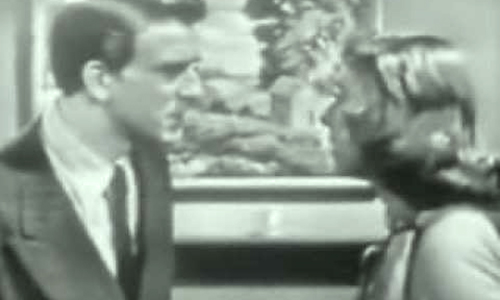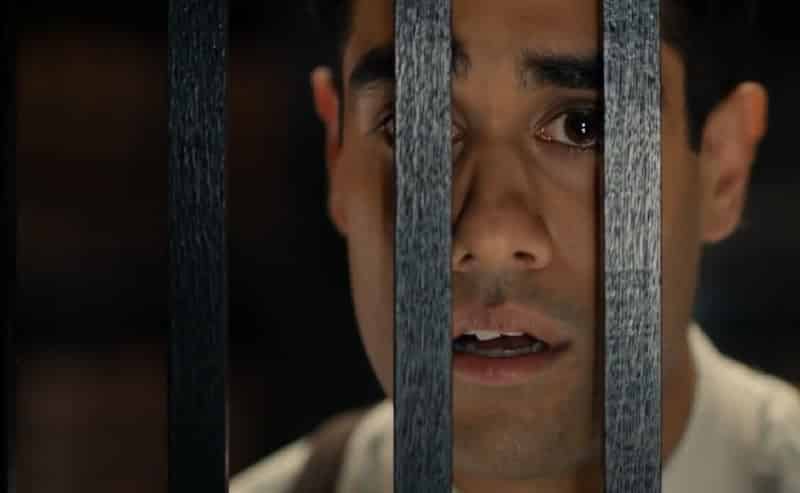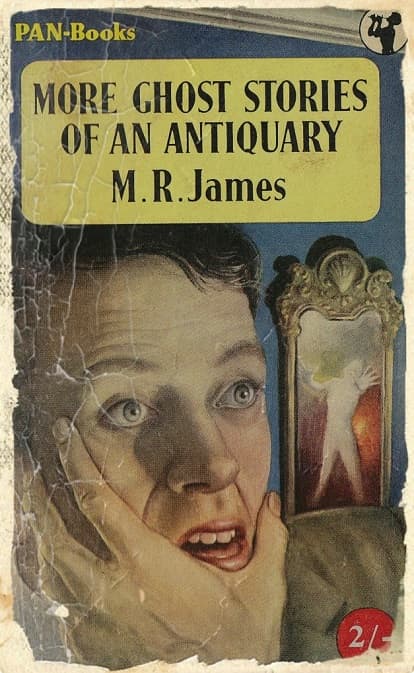What inspired Dr Rant’s burial in The Tractate Middoth? Guest writer MATTHEW E BANKS comes up with some ideas!
“Among other strange things connected with churches and graveyards is the practice of burying the dead in an upright position. Of this there are many instances on record.”
This is something that M R James would certainly have been aware of since he had a long held fascination with church architecture. As Eddie Brazil illustrates, church architecture was a passion of James’:
“He was adept at using the very fabric of the church as triggers in his stories. Tombs, stained glass, wooden carvings and even Bibles are employed to trap those who would unheed the warnings and so leave themselves open to vengeful horrors from beyond the grave.”
Whilst listening to A Podcast for the Curious for The Tractate Middoth it struck me that no-one had tried to find out who had inspired the burial of Doctor Rant.
It is certainly one of the most peculiar burials that James used within the confines of his stories and certainly one of the most visual.
Looking in the three volumes that contain story notes [Casting the Runes M Cox, 1987, A Pleasing Terror, 2001, Count Magnus & Other Ghost Stories, 2005] not one of them had any mention as to why Rant was buried the way he was or who inspired James to write the strange burial. The only time that Doctor Rant is discussed is when Mrs Simpson tells her ‘family story’ to Mr Garret and describes the bizarre way that her uncle was buried:
Mrs. Simpson, who had not yet resumed her work, and was looking at the fire thoughtfully, ‘I shall tell you the story. You will please keep it to yourself, if you don’t mind? Thank you. Now it is just this. I had an old uncle, a Dr. Rant. Perhaps you may have heard of him. Not that he was a distinguished man, but from the odd way he chose to be buried.’
I rather think I have seen the name in some guidebook.’
That would be it,’ said Miss Simpson. ‘He left directions—horrid old man!—that he was to be put, sitting at a table in his ordinary clothes, in a brick room that he’d had made underground in a field near his house. Of course the country people say he’s been seen about there in his old black cloak.’
…He was a clergyman, though I’m sure I can’t imagine how he got to be one: but he did no duty for the last part of his life, which I think was a good thing; and he lived on his own property: a very nice estate not a great way from here. He had no wife or family; only one niece, who was myself, and one nephew, and he had no particular liking for either of us…”
Although this does not tell us much, it does give us a hint as to where to search. While it is impossible to state with any certainty as to the likely inspiration for the burial scene, I would tentatively suggest that there are four people whose burials may have influenced James in the writing of Rant.
Mike Taylor and Will Ross in their Podcast to the Curious suggest that William McKenzie – a renowned railway engineer and gambler born in 1794 – might be James’ inspiration. He died in 1851, leaving his younger brother an estate of £341,841.

According to Ross and Taylor, local legend has it that McKenzie lost his soul to the Devil in a game of cards and so to cheat him out of his soul, McKenzie allegedly had his body seated at a table with a winning hand of cards in his hand. His logic being that if he looked as though he were alive, the Devil could not claim his soul. Elliot Davies reports that the spirit of McKenzie has been seen and like Rant, caused death:
Such a sighting reportedly took place one Sunday night in the autumn of 1871. Walking down Liverpool’s Maryland Street, respected doctor Lionel Harland heard footsteps approaching. Emerging from the gloom ahead of him he saw the foreboding figure of a tall man in a top hat and a flowing cape. ( )..this particular gent gave Dr. Harland the willies. He recognised him as none other than McKenzie; a man he’d known years ago who had died twenty years previously. ( )…McKenzie’s face glowed as if lit by fiery embers, whilst his eyes were black and lifeless like spent coals. It literally scared the good Dr to death. He’d suffer a fatal heart attack later that night.’
Jacqueline Simpson and C.E. Ward in their respective essays in defence of The Tractate Middoth in issue 8 of The Ghost and Scholars Newsletter suggest, ‘Mad Jack’ Fuller. He certainly would have been someone that M R James may have heard about, not only being a Sussex ‘legend’ but also from his time at Eton as well as both were educated there.
Fuller was born in 1757 and went on to attend Eton School in 1767. He had a varied career and retired in 1812, having the previous year, had a pyramid mausoleum built in the churchyard of Church of St. Thomas à Becket in Brightling, Sussex where he was interred after his death in 1834. Local legend had it that he was buried in his top hat and full dress, seated at a table with a glass of wine in hand. Jacqueline Simpson has correctly pointed out that this legend did not see print until the 1920s.

Simpson mentions Robert Chambers’ Book of Days’ (1861, vol. 1, pp804-808) stating that he: “mentions several men who left instructions that they should be buried at some favourite spot on their estates” and goes on to say “None of these, however, is in an underground brick room.” However, recent newspaper reports have brought to light a third contender; Sir James Tillie, a noted Cornish eccentric whose story James may have encountered, and who also features in Book of Days.
Born in 1645 and is described as ‘an extraordinary man of dubious character.’ He married the widow of Sir John Coryton (who he allegedly murdered), which made him a rich man and was latterly investigated by James II. He built Pentillie Castle in Saltash, Cornwall in 1698. When he died in 1713 it was stipulated in his will that he should not be buried, but instead be placed in a chamber under his folly, dressed in his finest clothes, bound to a chair, surrounded by his books, wine and pipe so as he could await resurrection.
For three hundred years the mystery of Tillie’s final resting place was open to conjecture and rumour. However, in 2012, following renovations of a mausoleum in the grounds of Pentillie castle, the mystery has been solved. Following excavations in the mausoleum floor, archaeologists found a brick-built roof and further investigation found a structure underneath which contained human remains. The locations for both tombs are similar in as much as Rant is buried in a field on his estate like Tillie, but where Tillie has a mausoleum hiding the location of his grave, James does not mention as to whether Rant’s tomb had a similar superstructure. There are various magazines and periodicals that talk of Tillie and his burial, all of which James could have read including: The Plymouth and Devonport Guide (1828), Devonshire and Cornwall illustrated (1832), The Parochial History of Cornwall (1838), The Saturday Magazine (1840) and The Western Antiquary (1884). This selection is far from exhaustive, but goes to show that after a hundred years after his death, Tillie’s burial was still being written about and discussed. For example, in 1853, in Willis’s Current Notes: A series of articles on Antiquities there is a heated letter disputing how Tillie was buried. This controversy had long been a subject of debate as twenty-one years earlier Devonshire and Cornwall reported:
…from the strange circumstances related by Hals, the Cornish topographer, respecting the interment, in the grounds here, of the above-mentioned Sir James Tillie. His burial-place is distinguished by a small tower, erected on a conspicuous eminence at a short distance from the mansion, northwards; and which hill, according to Lysons, he used to call Mount Ararat. Gilpin, in his ” Observations on the Western Counties,” characterises Tillie as ” a celebrated atheist of the last age;” and states, that, ” in ridicule of the Resurrection, he obliged his executors to place his dead body, in his usual garb, and in his elbow-chair, upon the top of a hill, and to arrange on a table before him, bottles, glasses, pipes, and tobacco; and, in this situation, ordered himself to be immured in a tower of such dimensions as he prescribed, where he proposed, he said, patiently to wait the event.—All this was done, and the tower, still enclosing its tenant, remains as a monument of his impiety and profaneness. The country people shudder as they go near it:—
‘Jteligio pavidos terrebat agrestes
Dira loci;—sylvam, saxumque tremebant.’ “*
Gilbert and Drewe, in their recent ” History of Cornwall,” say,”Nothing can be more false than this account of the body being placed in a chair, with a table laid out before it, with bottles, glasses,” &c.; and that, “on the contrary, the body was placed in a coffin, and deposited in a vault.”f—Hals, however, who was a contemporary with Tillie, has stated circumstances which partly correspond with the statement of Gilpin; and, in conclusion, says, “I hear lately, notwithstanding his promise of returning in two years’ space to Pentyley, that Sir James’s body is eaten with worms, and his bones, or skeleton, fallen down to the ground from the chair wherein it was seated, about four years after it was set up.”
• Vide ” Observations,” p. 234. The Latin quotation may be thus translated;—
. • . The fear-struck hind, with superstitious gaze,
Trembling and pale, tli’ unhallow’d tomb surveys,
And half expects, whilst horror chills his breast,
To see the spectre of its impious guest .
t The authors further state, that ” the last will and testament of Sir James Tillie has lately been examined by his heirs at Doctors’ Commons; and in this document it is observable, that, so far from his principles being atheistical, they breathe throughout a disposition fraught with the utmost submission to the will of Divine Providence, and a perfect confidence in the wisdom and mercies of the Creator.”
The interesting thing here is that it mentions that the local people were scared to go near Tillie’s tomb, believing that his spirit roamed free. This could be seen as comparable to what Mrs Simpson says of her uncle: “Of course the country people say he’s been seen about there in his old black cloak.”10 It is also interesting to note that while Tillie initially left his estate to his nephew, it later passed to John Tillie Coryton, who in 1809 had a considerable portion of the old mansion demolished and erected a gothic building for his own residence. Is this why Doctor Rant went to murder his nephew, because he was going to alter his home?
Furthermore, Tillie’s religious beliefs were brought into question with periodicals stating that he was a celebrated atheist and that his chosen method of burial was to mock God, although this later turned out not to be true. Could James have used this question of faith as part of the character of Rant – a clergyman who was actually an atheist, whose burial was to mock God – again taking Tillie as his inspiration? It is this speculation and circumstantial evidence that leads me to venture that Tillie is, if not completely, the inspiration for Rant. Of course there are considerable differences between Tillie and Rant, the biggest being that legend has it that Tillie was brought food and wine for two years after his death until his servants could stand it no longer. Another difference is that that they were dressed differently; one dressed in ordinary clothes, the other in his finest, but this could be James just reversing that aspect.

In contrast neither McKenzie nor Fuller seem to appear in ‘guide books’6 or have as much written about their final resting places as Tillie does. Further to this both Fuller and McKenzie have inconsistencies that detract to their possible influence on James’ writing. Despite local legend, it was not until seventeen years after McKenzie was buried that the pyramid was built on top of his grave which negates his influence. As for Fuller, his legend did not see print until after The Tractate Middoth was written and the legend was discovered to be a myth when renovations in 1982 proved that he was buried in the traditional manner.
It is also plausible that James may have come across Tillie on one of his excursions to Cornwall. We know that he visited the Bensons at Lis Escop, Truro in December 1882 and six years later in 1888 when he stayed at St Ives. Again this is speculative, but there is one burial that James would have heard about without fail and that is the burial (or non-burial) of Sir John Knill.
Knills Steeple dominates the St Ives skyline and can be seen as far away as Carn Brea. When James visited St Ives in 1888 with his friend George Duckworth they stayed with the Stephen family at Talland House in St Ives and could not have failed to have seen the steeple. As an antiquarian, I would suggest that James may have enquired about the steeple and learnt about its history. Matthew’s guide for 1884 has this to say about the steeple and the tradition that goes with it:
“… This is a name of a conspicuous granite obelisk, and from that of the hill on which it stands. John Knill was mayor of St. Ives in 1766, and though a man of excellent character, slightly eccentric. He built this obelisk with a view to be buried in the vault which it contains, but his body was interred elsewhere. However, certain droll ceremonies which he directed to be performed here every five years, take place regularly.
At his death Knill gave his body to the anatomists for dissection, in London; he also left certain property to the vicar, mayor, and collector of St. Ives, and directed that every five years £10 should be expended on a dinner, and that ten virgins dressed in white should walk in procession with music, from the market house to the monument, around which the whole party was to dance singing the hundredth psalm; £1 was given to the town fiddler, and there were also legacies for the oldest widower and widow in the parish. This quintennial commemoration is made the occasion for a good deal of jollity, in which the entire population joins, indeed the whole proceeding is quite mirth-provoking; nor is the least laughable part of it the air of martyrdom visible on the faces of the unfortunate vicar and mayor, as they sedately waltz around on the upper step of the monument, hand in hand with the ten very young virgins and the venerable representatives of widowhood…
…From Knill’s Steeple the view of the Bay, with Godrevy, St. Agnes Beacon, and Carn Brea, is very fine.”
Of course, neither Knill’s Steeple or his death hold very little in common with Doctor Rant and his brick room in a field.
The closest by far in terms of similarity and notoriety is Sir James Tillie.
There is the possibility that all these characters influenced James in his writing of Rants’ tomb or as Reverend F Wagstaff states: “… Of oddities connected with funeral ceremonies, apart from any peculiarity in the place of burial, the catalogue is endless.”
MATTHEW E BANKS is a graduate of University of Plymouth. He lives in Cornwall with his wife Sam. Matthew’s main fields of interest are the supernatural in all its manifestations, horror film history and the ghost story genre.







